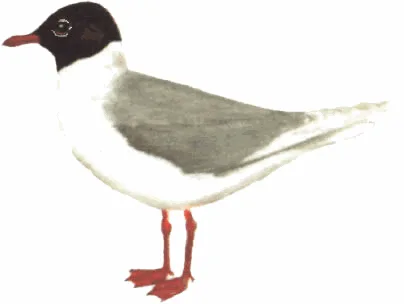
Mediterranean Gull
[order] CHARADRIIFORMES | [family] Laridae | [latin] Larus melanocephalus | [UK] Mediterranean Gull | [FR] Mouette melanocephale | [DE] Schwarkopf-Mowe | [ES] Gaviota Mediterranea | [NL] Zwartkopmeeuw
Subspecies
Monotypic species
Physical charateristics
Head black, with prominent white eye-crescents. Neck white, upperparts very pale grey, flight-feathers white, with outer web of outer primary black, tail white, underparts white. Bill scarlet, with variable dark subterminal band, often mainly on lower mandible, and often with yellow tip. Legs bright red, iris blackish brown, with red orbital ring. Difers from L. redibundus in full black hood covering most of nape, bulkier body, larger head, heavier bill, paler general appearance, lack of black at wingtip.
Listen to the sound of Mediterranean Gull
[audio:http://www.aviflevoland.nl/sounddb/M/Mediterranean Gull.mp3]
Copyright remark: Most sounds derived from xeno-canto
| wingspan min.: | 100 | cm | wingspan max.: | 115 | cm |
| size min.: | 35 | cm | size max.: | 38 | cm |
| incubation min.: | 23 | days | incubation max.: | 25 | days |
| fledging min.: | 35 | days | fledging max.: | 25 | days |
| broods: | 1 | eggs min.: | 2 | ||
| eggs max.: | 3 |
Range
Eurasia : West
Habitat
Breeds on Mediterranean coasts, costal lagoons, steppe lakes and marshes in open lowland areas, favouring sparse vegetation, but generally avoiding barren sand.
After breeding season mainly on coasts, estuaries, harbours, marshes, inland lakes, fields and grasslands.
Appears able to adapt more readily than many other species to new habits, both breeding and wintering.
After breeding season mainly on coasts, estuaries, harbours, marshes, inland lakes, fields and grasslands.
Appears able to adapt more readily than many other species to new habits, both breeding and wintering.
Reproduction
Laying first half of May. Colonies usually under 1000 pairs, occasionally single pairs in colonies of other species. Nest on sparsely vegetated sites, or thickets or reedbeds, a shallow depression lined with grass. Nests dense, with nest rims as close as a few cm. 2-3 eggs, incubation 23-26 days. Chick spotted brown, grey and buff on head, with 2-3 broad brown bands on buffish back, and pale greyish to pinkish buff underparts. First breeding at 2-3 years.
Feeding habits
In breeding season, diet based on aquatic and terrestrial insects, also gastropods and small numbers of fish, worms and some rodents.
Flocks descend on agricultural fields when abundant insect pests are detected. May fly up to 80 km from colony to feed on grassland. On migration and in winter, when shifts to coasts and harbours, consumes fish, molluscs and offal, occasionally sewage and refuse.
Feeds by aerial hawking, surface-plunging, contact-dipping, and picking from water surface while swimming. Walks and runs after prey on ground.
Flocks descend on agricultural fields when abundant insect pests are detected. May fly up to 80 km from colony to feed on grassland. On migration and in winter, when shifts to coasts and harbours, consumes fish, molluscs and offal, occasionally sewage and refuse.
Feeds by aerial hawking, surface-plunging, contact-dipping, and picking from water surface while swimming. Walks and runs after prey on ground.
Conservation
This species has a large range, with an estimated global Extent of Occurrence of 100,000-1,000,000 km2. It has a large global population estimated to be 570,000-1,100,000 individuals (Wetlands International 2002). Global population trends have not been quantified, but the species is not believed to approach the thresholds for the population decline criterion of the IUCN Red List (i.e. declining more than 30% in ten years or three generations). For these reasons, the species is evaluated as Least Concern.
Until the 1940’s this species inhabited the Black Sea, southern Russia, Turkey and Greece. Since the late 1950’s it is increasing its numbers and extending its distribution westwards. It has colonised subsequently Hungary, Italy, Germany, the Netherlands, Belgium, France and Great Britain. The western populations of the European Union amount to not more than 2000 breeding pairs, however, and they remain marginal compared to the total European population, centred on Ukraine and estimated at 250000 breeding pairs. The Greek population is fluctuating between a few hundreds and over 7000 breeding pairs
Until the 1940’s this species inhabited the Black Sea, southern Russia, Turkey and Greece. Since the late 1950’s it is increasing its numbers and extending its distribution westwards. It has colonised subsequently Hungary, Italy, Germany, the Netherlands, Belgium, France and Great Britain. The western populations of the European Union amount to not more than 2000 breeding pairs, however, and they remain marginal compared to the total European population, centred on Ukraine and estimated at 250000 breeding pairs. The Greek population is fluctuating between a few hundreds and over 7000 breeding pairs

Migration
Migratory. Some Black Sea birds winter there, especially on Caucasian coast and Crimea, but bulk of population winters in Mediterranean. Some numbers also emerge through Straits of Gibraltar to winter on Atlantic coasts, and since 1950s has occurred with increasing frequency on coasts of western and north-west Europe. Migrations mainly coastal, but minority regularly cross Asian Turkey and small numbers follow major river valleys in eastern and central Europe.
Distribution map

